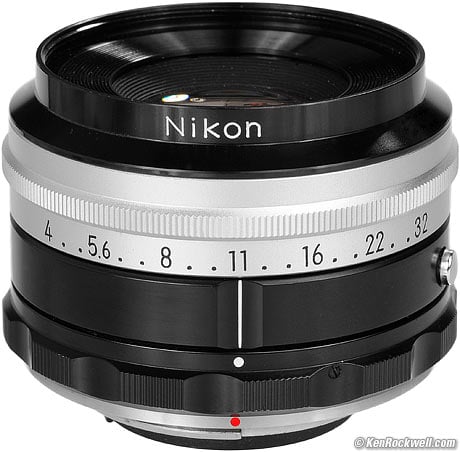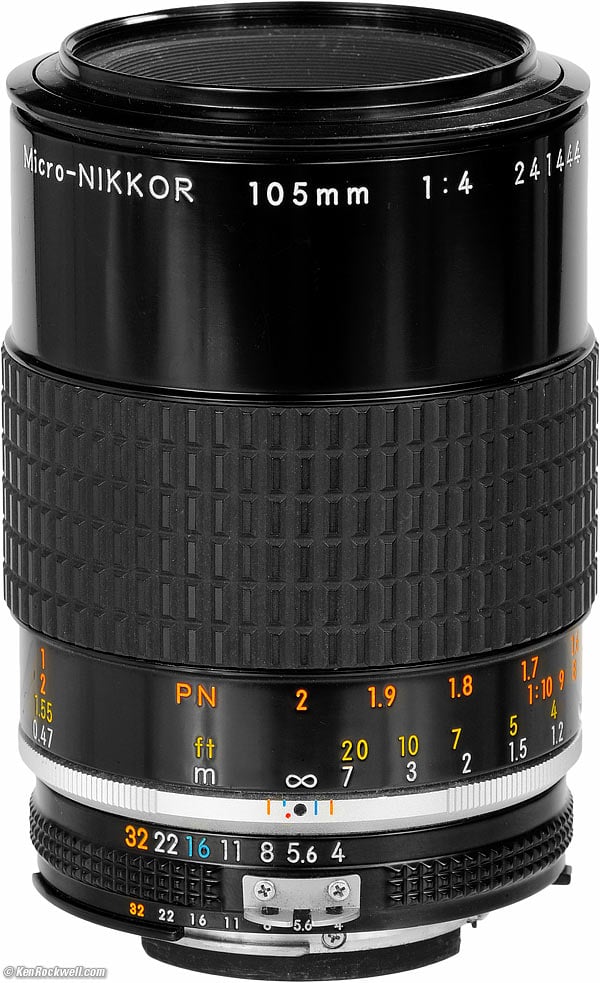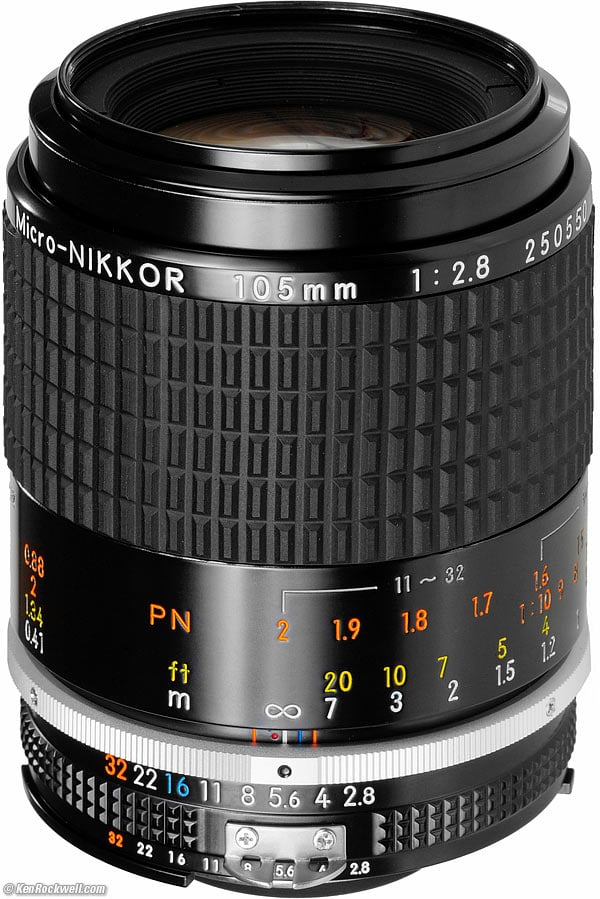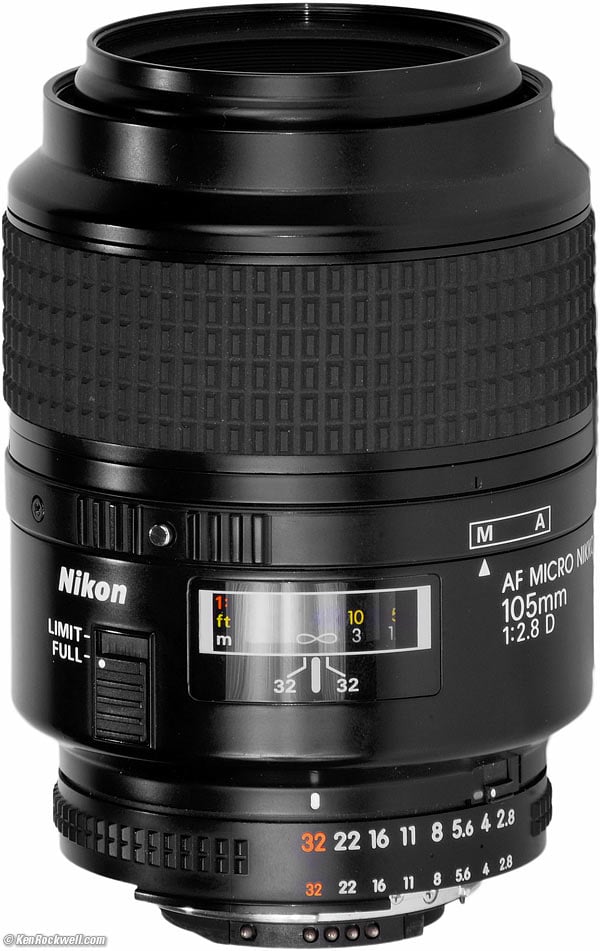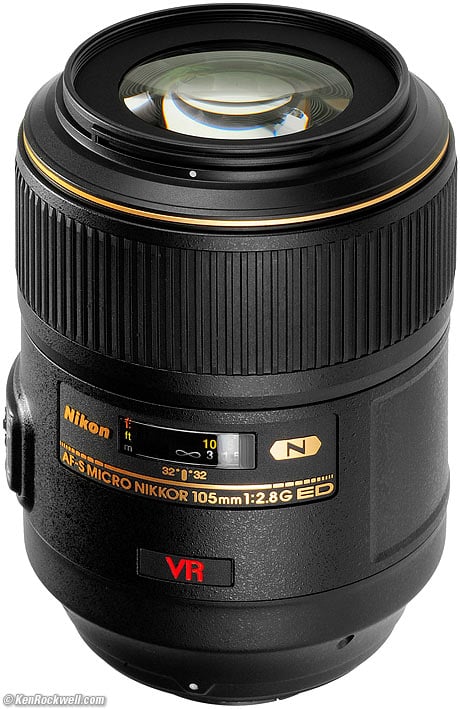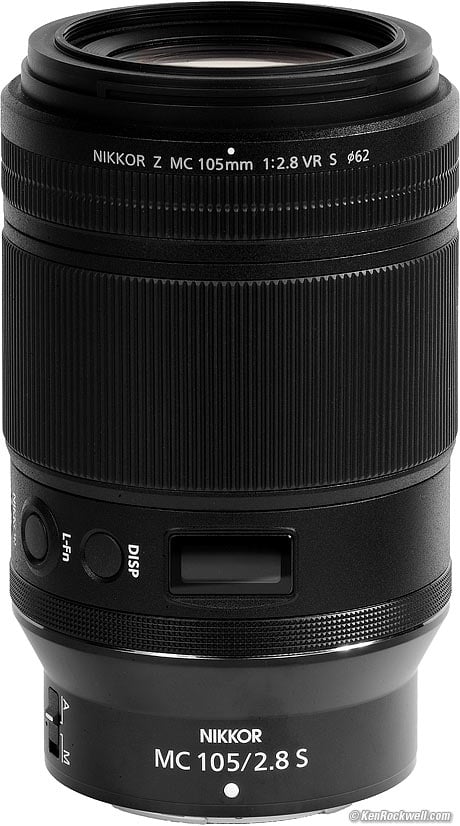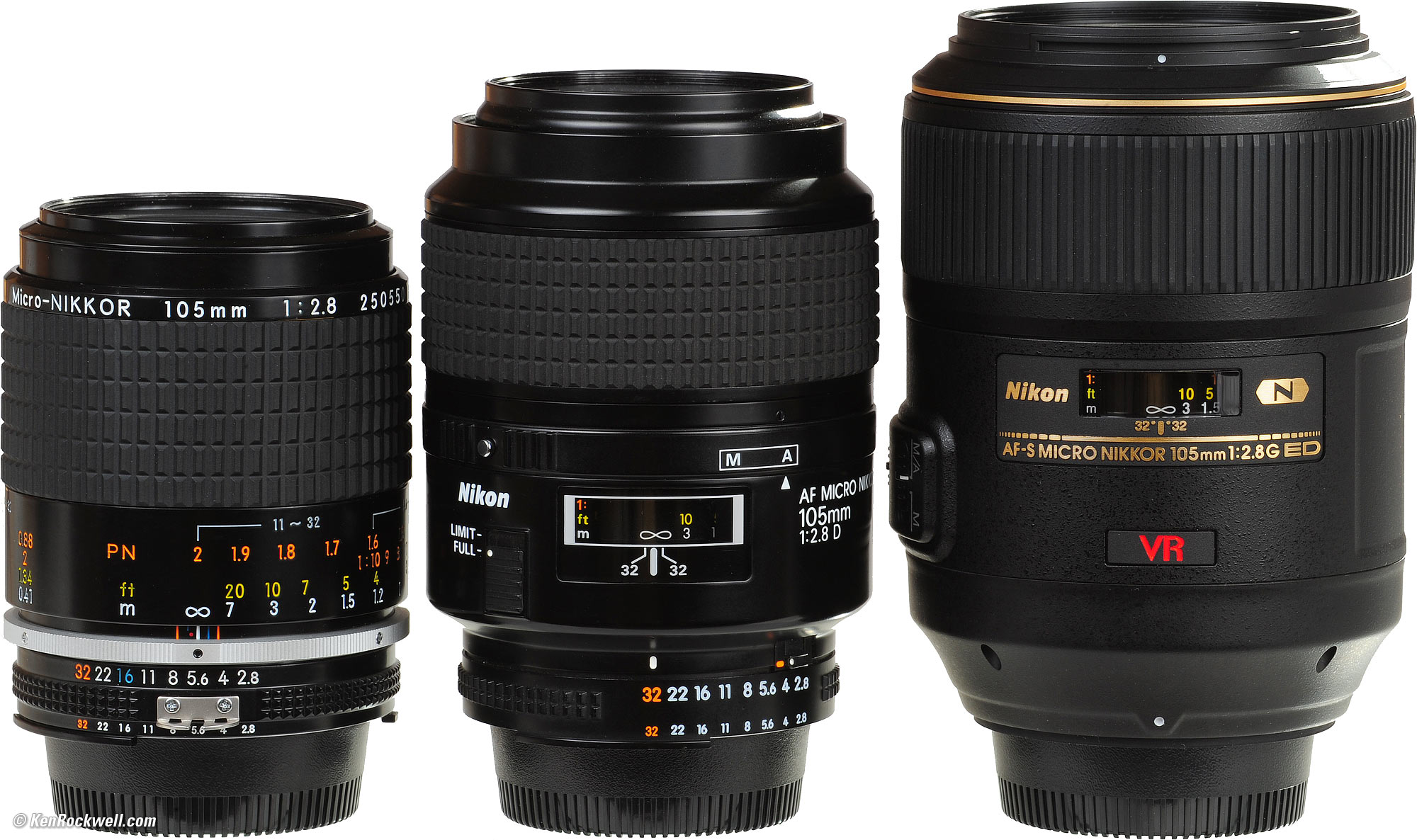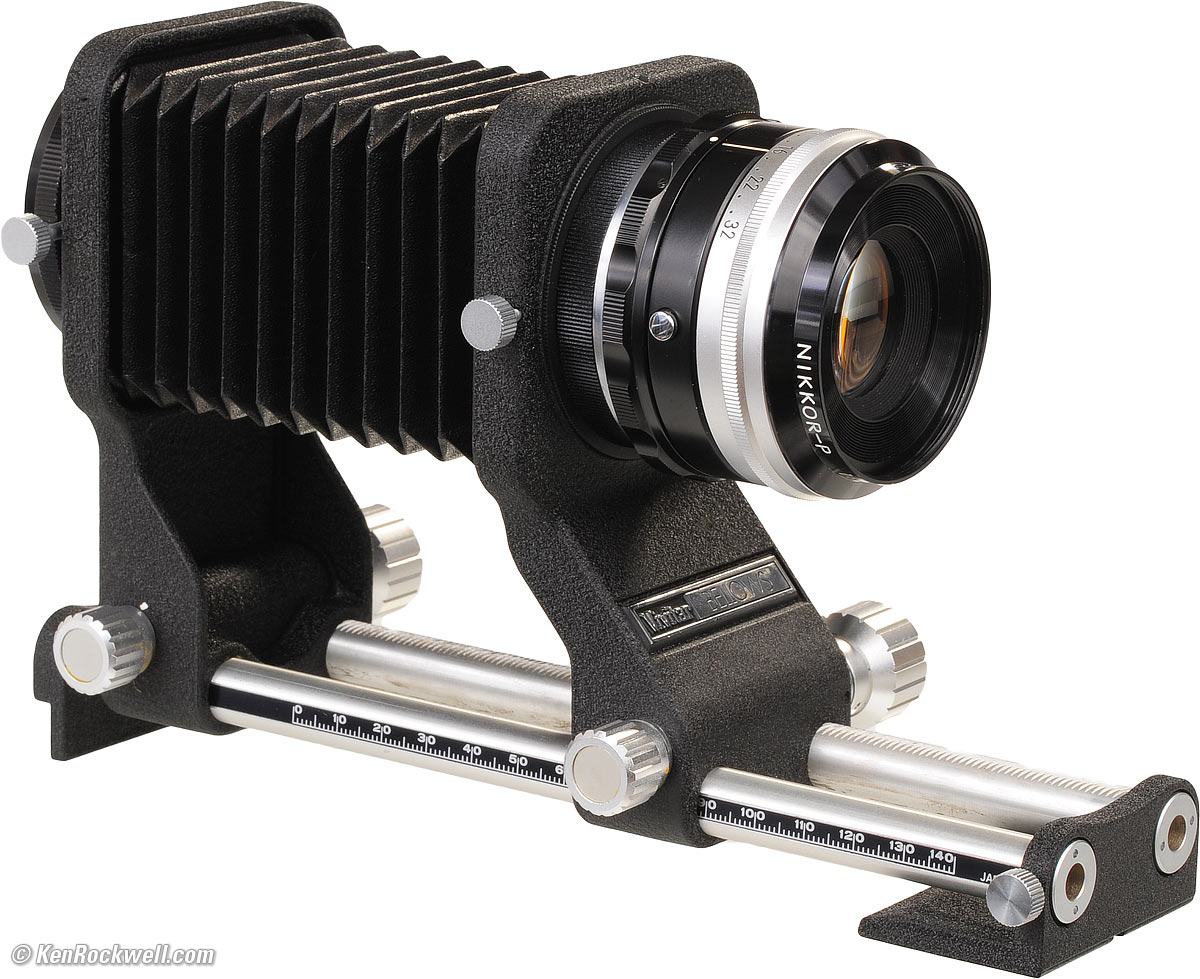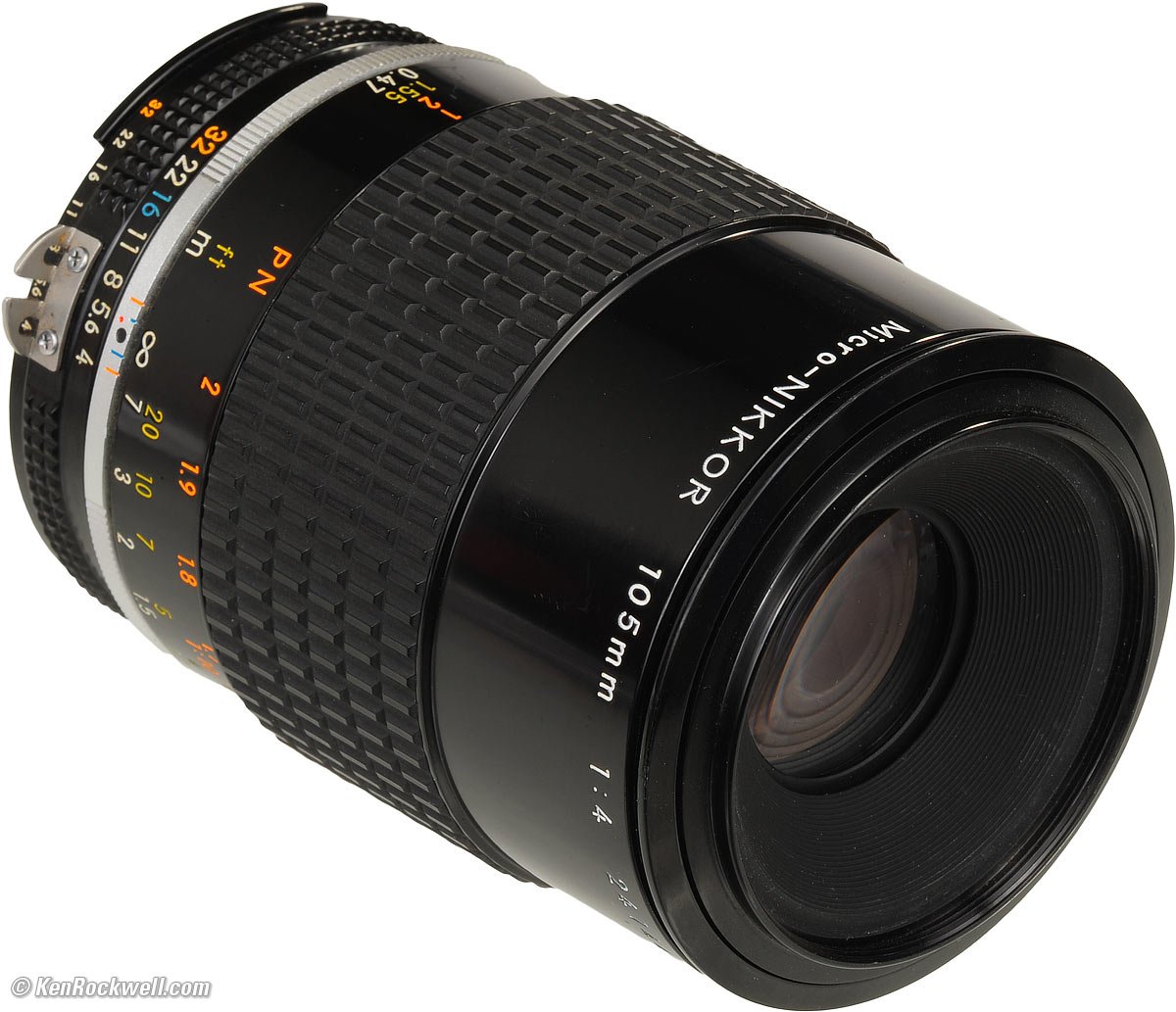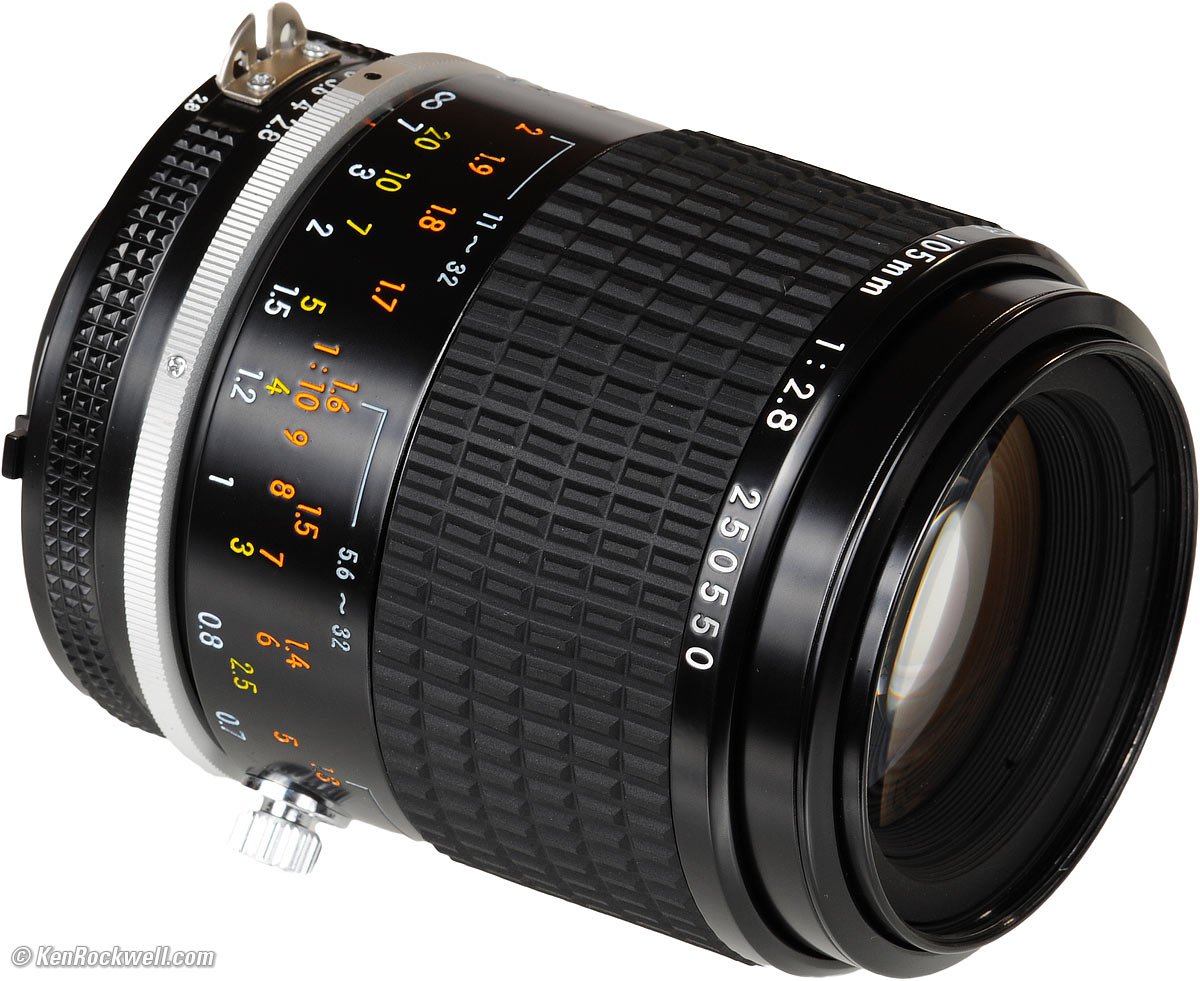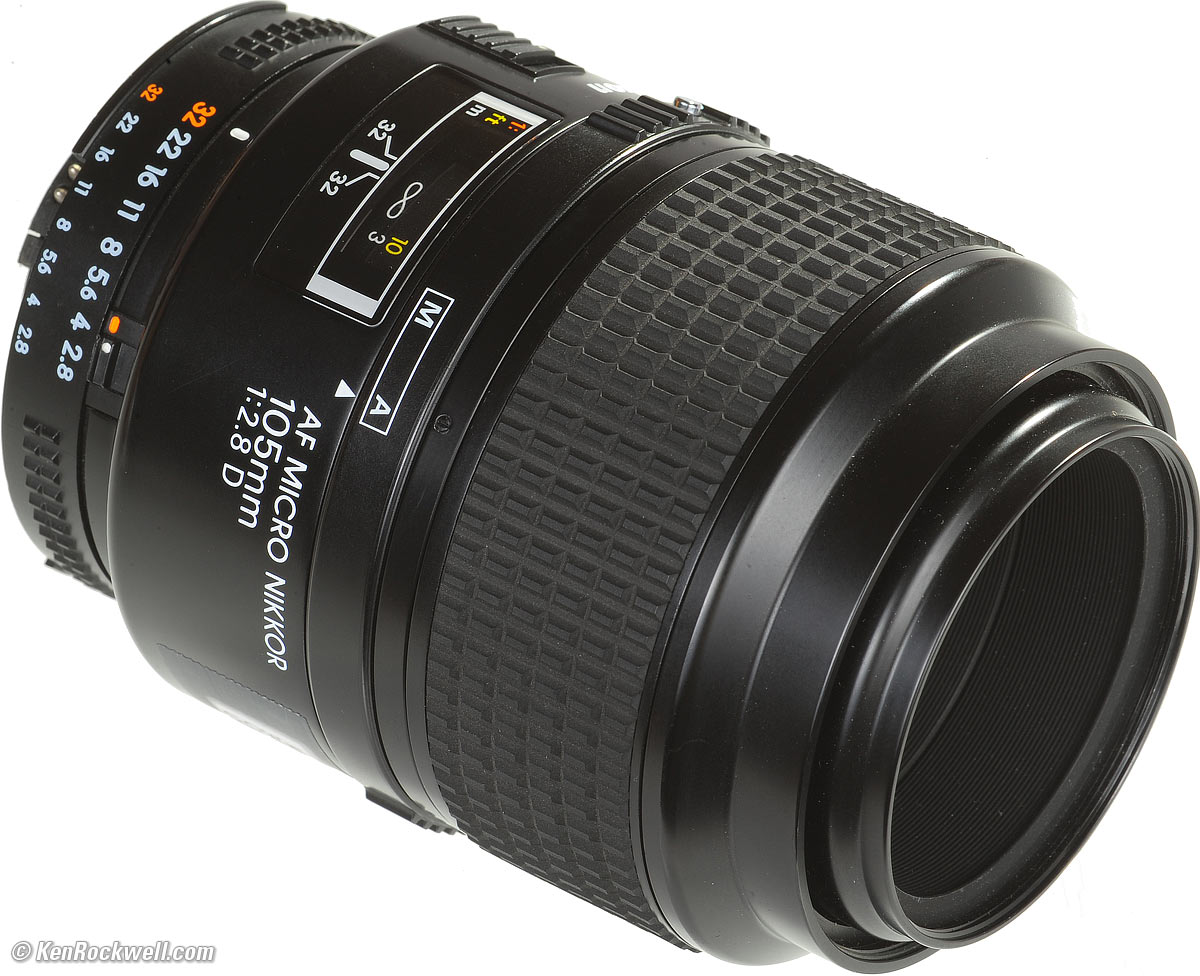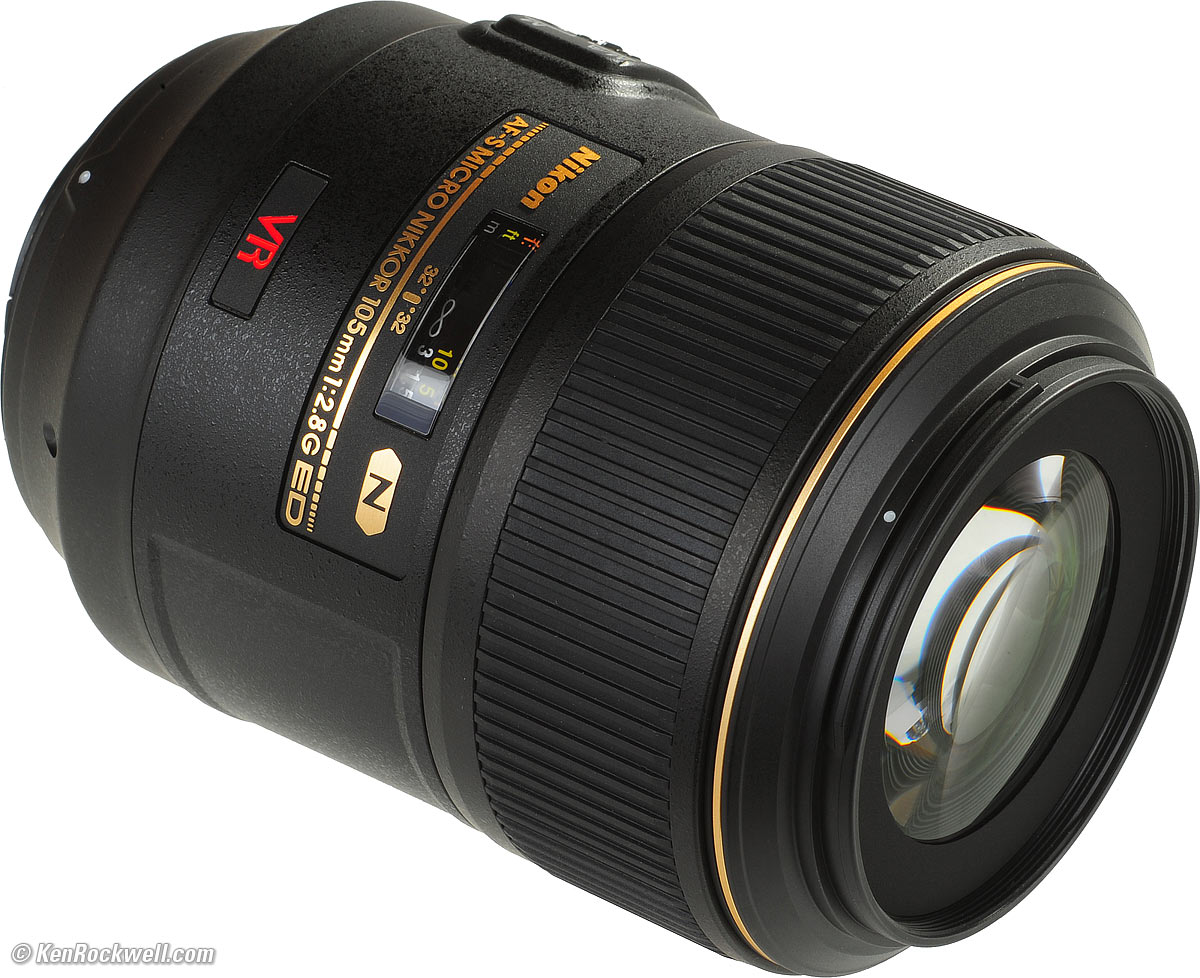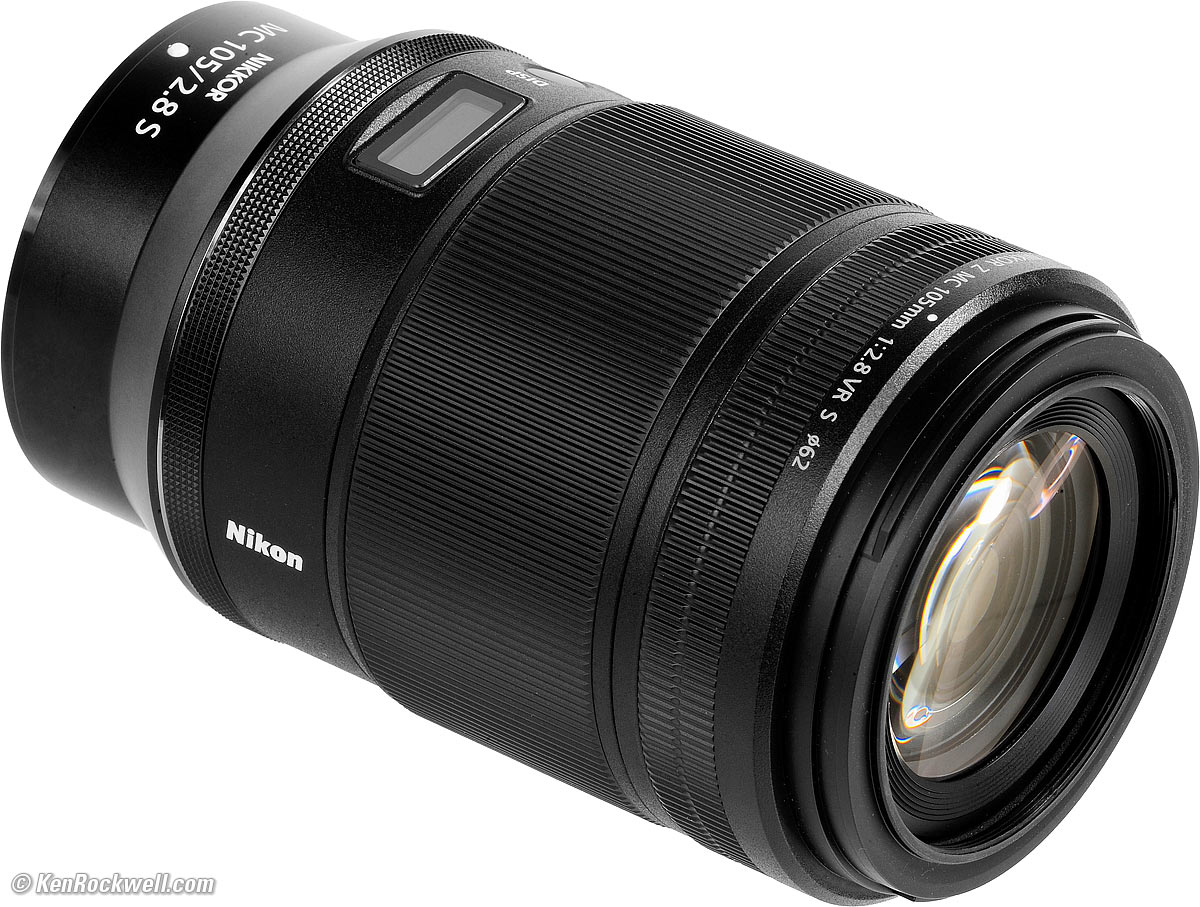All Nikon 105mm Macro Lenses Compared
Introduction History Recommendations
(to scale, if these columns display at equal width) |
||||||
Anni |
1970-1974 |
1975-1983 |
1983-2021 |
1990-2007 |
2006-2021 |
2021- |
What's New |
First Nikon 105 Macro ever |
First Nikon 105 Macro in a focusing mount |
CRC for better optical quality at every distance and faster f/2.8 for easier focusing |
First Autofocus 105 Macro |
First VR Macro |
First 105 macro native to the Z system |
Maximum Repro Ratio1 |
depends on bellows |
0.5× |
0.5× |
1× |
1× |
1× |
Focusing |
Bellows only (no helicoid) |
Manual |
Manual |
Screw-type AF (doesn't work on mirrorless) |
||
Autofocus5 |
no |
no |
no |
only on cameras with an in-body AF motor, not on Z cameras |
Yes |
Yes, but only on Z cameras |
Manual Focus |
depends on bellows |
Excellent |
Excellent, but can be a little stiff. Also has a friction focus lock screw. | Very Good, but have to unlock and rotate a focus-mode ring to swap between AF and MF | Excellent; just grab the excellent focus ring for instant manual override | Poor. There's a time-delay between the electronic focus ring and the lens actually focussing, making it maddening to try to focus manually. |
Diaphragm |
12 blades, preset |
7 blades |
7 blades |
7 blades |
9 rounded |
9 rounded |
f/min (at inf.) |
f/32 |
f/32 |
f/32 |
f/32 |
f/32 |
f/32 |
Filter size |
||||||
VR? |
no |
no |
no |
no |
Yes |
Yes |
Optics (elements/groups) |
5/3 |
5/3 |
10/9, CRC |
9/8, CRC |
14/12 (1 ED), CRC |
16/11 (3 ED, 1 Asph), CRC |
Optical Quality |
Superb |
Superb |
Superb |
Superb |
Superb |
Superb |
Coatings |
Single-coated |
|||||
| Yes (with FTZ), but no aperture control or data communication | Yes (with FTZ), but no aperture control or data communication | Yes (with FTZ), but no aperture control or data communication | Yes (with FTZ), but no autofocus | Yes, with FTZ |
Yes |
|
Yes |
Yes |
Yes |
Yes |
Yes |
no |
|
Yes |
Yes |
Yes |
Yes |
Yes |
no |
|
Yes |
Yes |
Yes |
Yes |
no |
no |
|
Materials |
All metal |
All metal |
All metal |
Plastic on outside, metal on inside |
Mostly metal |
Mostly plastic |
Made in |
Japan |
Japan |
Japan |
Japan |
Japan 2006-2008 China 2008-2021 |
Thailand |
Diameter |
2.4" 64mm |
2.93" F & AI 74.5mm F & AI |
2.36" 66.5mm |
2.95" 75mm |
3.27" 83mm |
3.34" 85mm |
Length2 |
1.71" 43.5mm |
3.78" 96mm |
3.29" 83.5mm |
4.11" 104.5mm |
4.57" 116mm |
5.6" 140mm |
Weight3 |
8.6 oz. 242g |
17.6 oz. 500g |
18.0 oz. 510g |
19.8 oz. 562g |
26.5 oz. 752g |
21.9 oz. 622g |
Price, 7/2022 |
1.) Without accessories. Add extension tubes or closeup lenses for higher magnification.
2.) Extension from flange.
3.) Actual measured weights.
4.) Approximate, if you know How to Win at eBay.
5.) Autofocus is for use at normal distances. Use manual focus at macro distances.
NIKKOR AI 105mm f/2.8s, AF 105mm f/2.8D and 105mm f/2.8G VR. enlarge.
|
|
This all-content, junk-free website's biggest source of support is when you use any of these links to approved sources when you get anything, regardless of the country in which you live. Thanks for helping me help you! Ken.
July 2022 Nikon Reviews Nikon Lenses All Reviews
Why fixed lenses take better pictures
Introduction top
Introduction History Recommendations
Click anything for detailed reviews of any of these lenses.
Micro means the same thing as macro.
50mm, 55mm, and 60mm macro lenses are "short" macro lenses, best suited for copying backlit film or slides, or flat art or documents from reasonable distances. I list all these lenses here.
105mm macro lenses are "normal" macro lenses for general purpose use. They do most things well, and most importantly let us get farther away from our subject so we're less likely to block our own light. The 105mm lenses give us a precious few more inches of "working room" between the front of our lens and our subject at 1:1 compared to 50mm lenses.
For serious macro shooting we prefer 200mm lenses because they let us get far enough away so we don't block out own lighting, don't annoy live subjects, and most importantly for product shots render items with a much more natural perspective. Every product photo on this website was shot with my AF 200mm f/4D for exactly this reason. Nothing three-dimensional looks right when shot from just a foot away; the 200mm lenses let us get another foot or two back. Avoid the classic manual-focus AI Micro-NIKKOR 200mm f/4s; in its day it was coveted by bug photographers because they could stand farther away from the subjects, but on digital it has more lateral color fringes at macro distances than any other Nikon macro lens today.
History top
Introduction History Recommendations
Nikon has been making 50mm micro (macro) lenses since the 1950s for their rangefinder cameras.
Nikon's first SLR macro lens was the 55mm f/3.5 Micro-NIKKOR (1961-1979), and their first 105mm macro lens came out in 1970:
1970-1974
NIKKOR-P 105mm f/4 on a Vivitar Bellows.
Nikon's first 105mm f/4 micro was a simple 5 element, 4 group design. It was a short-mount lens for use on bellows. You had to supply the bellows.
Even today this is the best system for 35mm, DSLR and mirrorless cameras for magnifications above life-size. You can focus the bellows from infinity directly down to extremely close distances, depending on your choice of bellows.
The advantage is that you get continuous focus from infinity to larger than life, however, the necessity of carrying a big bellows made it less attractive for general photography.
This version was single-coated, which is more than adequate for this simple design, and had a wonderful 12-bladed preset diaphragm. All newer versions below are SIC multicoated.
To select an aperture, press both unlock buttons on the middle black ring, and rotate the middle black ring to the desired aperture. To focus, turn the rearmost ring to the left to open the diaphragm to f/4. To meter or shoot, flick the rear ring to the right; it will stop exactly at the set and locked aperture. Flick the rear ring back and forth as you focus and shoot. Now do you appreciate the automatic diaphragms we've had in most conventional lenses since the 1960s?
Nikon made about 7,000 of these short-mount lenses.
1974-1983 top
Nikon AI Micro-NIKKOR 105mm f/4s.
The same 105mm f/4 optics were put in a traditional helical focus lens which focused from infinity down to 1:2 (half life-size).
This classic 105mm f/4 is still a favorite because it is the only Nikon 105mm Micro with a built-in, slide-out hood.
Nikon made three versions of this lens. All three versions from 1974-1983 use exactly the same 5-element optical design, and all have excellent performance; it's just the mechanics of the barrel that changed.
This f/4 lens is more than fast enough for use on today's mirrorless and DSLR cameras, and since autofocus and VR aren't used for serious macro work with strobes, this old f/4 lens is just as good as Nikon's newest for macro use!
1974-1976: F
The first focusing (conventional barrel) version is for the Nikon F won't mount on most modern cameras unless it is first updated to AI, which isn't a big deal, but why bother when you can buy an AI version just as easily today?
This version has only one set of numbers on the aperture ring.
Nikon made about 13,000 of these.
1977-1981: AI
The AI version is wonderful, since it works on almost all Nikon cameras.
This version has two sets of numbers on the aperture ring, however the small "32" is white, not orange as shown on the AI-s version above.
This version also has colored depth-of-field lines engraved on the lens barrel that become more visible as focused more closely, not colored dots on the silver grip ring as shown on the AI-s version above.
Nikon made about 44,000 of these.
1981-1983: AI-s
This AI-s version does the same thing as the AI version.
The AI-s version is identified by having both f/32 markings painted orange on the aperture ring.
Nikon made about 25,000 of these.
1983-today top
Nikon AI Micro-NIKKOR 105mm f/2.8s.
The 10 element, 9-group 105mm f/2.8 AI-s replaced the 105mm f/4. It focuses from infinity down to 1:2 (half life-size).
It's f/2.8 speed made it much easier to focus using split-image rangefinders on manual-focus cameras.
This lens is the first 105mm Micro to use floating elements (the Close Range Correction (CRC) system) to optimize performance at all distances. Nikon still makes this manual focus lens because it has many uses with industrial and process cameras. It has a focus lock, and unlike any of the autofocus lenses below it is ideal if you need to set a precise focus distance and leave it fixed that way.
1990-2007 top
Nikon AF MICRO NIKKOR 105mm f/2.8D.
Nikon introduced the first autofocus 105mm lens, the 9 element, 8 group 105mm f/2.8 AF, in 1990. It was updated to AF-D in 1993. This is the first 105mm lens able to focus to 1:1 (life size) all by itself.
It uses the traditional mechanical (motor in camera body or "screw-type") autofocus drive, so it will not autofocus on the FTZ adapter on mirrorless Z cameras, but otherwise works great on them with manual focus — which is how we usually shoot macro.
2006-2021 top
Nikon Micro-NIKKOR AF-S 105mm f/2.8G VR.
The 14-element AF-S Micro-NIKKOR 105mm f/2.8G VR is the first Nikon micro (macro) with VR optical image stabilization.
It's also the first autofocus Nikon macro lens with instant manual-focus override; just grab the focus ring at any time with no need to move a switch. This AF-S system also means that it works and autofocuses just fine on the FTZ adapter on mirrorless Z cameras.
2021-today top
The newest Z 105/2.8 VR Macro only works on Z-series mirrorless cameras; it can't adapt to any 35mm or DSLR camera, while the older lenses can be adapted to Z cameras.
It's the first 105mm macro with electronic focus, which is great for automated focus stacking, but crummy for manual focussing because there is always a lag between turning the ring and the lens actually focussing, making manual focus quite unpleasant.
Recommendations top
Introduction History Recommendations
All of these lenses have superb optics, especially by modern standards. The reason there are so many different versions is for different features, like brighter focusing, autofocus or VR, not optical quality. Newer lenses aren't sharper; they just have more features like AF and VR that help with general photography, but that you don't need for serious macro shooting. All of these lenses are ultra sharp and devoid of distortion. Put an original 105 mm f/4 on a D850 or Z9 and prepare to be amazed.
The worst thing you can do is try to shoot macro hand-held with autofocus under available light because you won't be able to stop down enough to get anything in focus. When you do stop down to f/22 you'll need a tripod to hold the camera steady, but since your subjects are probably alive and moving, abandon all hope of a sharp shot under available light. AF systems can't keep up with even small amounts of motion at macro distances — and they can't figure out what part of the subject you want in focus.
If you're serious about macro shots, the best way to do it is to 1.) shoot at ISO 100 or below, 2.) use flash or studio strobes which 3.) make it easy to shoot at f/22 to f/32 for getting at least a little depth of field (there is zero depth-of-field at macro distances), and 4.) the flash or strobes eliminate camera shake (and the need for VR) so you can forget the tripod. 5.) Use manual focus because only you know what's the most important part of the subject to have in focus. Autofocus systems are awful for macro shooting because they have no idea what part of the image you want in focus; they can't just assume it's the closest thing and there are no human faces.
Once you learn this, you'll realize that you don't need autofocus or VR.
The obvious choice for bargain shoppers is the 105 mm f/4, which is half the price of any of the others. Remember to set the "Non-CPU Lens Data" menu option to 105mm and f/4.
For most folks the 105/2.8 AF is a better choice for not that much more money because it offers full data communication with all Nikon DSLRs and mirrorless cameras. It can't autofocus on mirrorless, but for serious macro we don't need VR or autofocus, and manual focus is excellent with the 105/2.8 AF once you turn its ring to "MF."
The 105/2.8 VR is half the price and has much better manual focus than the newest Z 105/2.8 VR, and it offers VR and autofocus, even adapted to Z cameras.
Hint: I love my 105 mm f/4, and even though I have the others, often grab it first as it's the lightest and has the best manual focus feel. The 105/2.8 AI-s has a more complex Close Range Correction (CRC) system, which makes focus stiffer.
As I said at the top, I actually use my Nikon AF Micro-NIKKOR 200mm f/4D for all my macro work as I prefer the longer working distance, and I shoot it in manual focus mode and it has no VR.
© Ken Rockwell. All rights reserved. Tous droits réservés. Alle Rechte vorbehalten. Ken Rockwell® is a registered trademark.
Help Me Help You top
I support my growing family through this website, as crazy as it might seem.
The biggest help is when you use any of these links when you get anything. It costs you nothing, and is this site's, and thus my family's, biggest source of support. These places always have the best prices and service, which is why I've used them since before this website existed. I recommend them all personally.
If you find this page as helpful as a book you might have had to buy or a workshop you may have had to take, feel free to help me continue helping everyone.
If you've gotten your gear through one of my links or helped otherwise, you're family. It's great people like you who allow me to keep adding to this site full-time. Thanks!
If you haven't helped yet, please do, and consider helping me with a gift of $5.00.
As this page is copyrighted and formally registered, it is unlawful to make copies, especially in the form of printouts for personal use. If you wish to make a printout for personal use, you are granted one-time permission only if you PayPal me $5.00 per printout or part thereof. Thank you!
Thanks for reading!
Ken.
